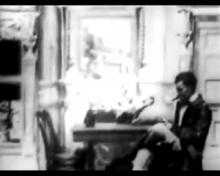Stop trick

A stop trick (also referred to as "locking off" or a "Jeannie Cut") is a film special effect. It occurs when an object is filmed, then while the camera is off, the object is moved out of sight of the camera, then the camera is turned back on. When the film is watched, it thus seems to the viewer that the object disappears.
Georges Méliès accidentally developed the stop trick while filming street traffic in Paris. The gate mechanism of his camera jammed; the traffic continued moving normally but Méliès's camera stopped filming until he could free the gate mechanism. Later, when he screened the printed footage of the street traffic, he was astonished to see an omnibus suddenly turn into a hearse. What actually happened is that the omnibus moved out of frame after the camera jammed, to be replaced by the hearse before the camera continued filming. Méliès used this technique to do magical tricks. For example, he would film a magician and a girl; the magician would make a gesture and Melies stopped the camera. He told the girl to go out of sight and started the camera again. When viewing the finished film, it looked like the girl disappeared suddenly after the magician's gesture.
This technique is not to be confused with the stop motion technique, in which the entire shot is created frame by frame.